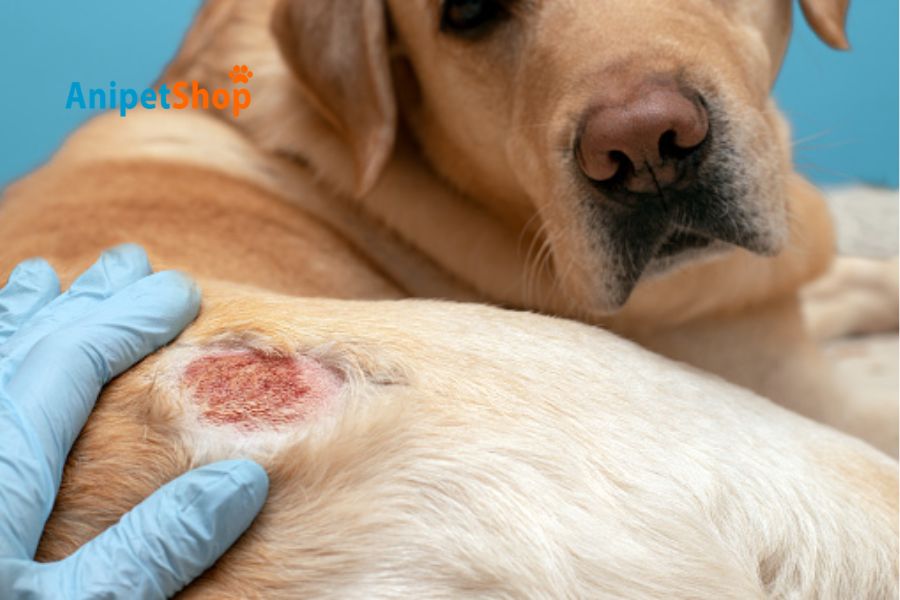Flea Bites on Dogs Treatment: Approaches to Prevent The Symptoms
Flea bites prevalent in various environments, not only cause discomfort but also pose potential risks to a dog’s health. Beyond mere irritation, flea bites can escalate into a condition known as flea allergy dermatitis (FAD), wherein the dog’s immune system overreacts to flea saliva, triggering severe skin reactions and discomfort. In this article, we provide information on flea bites on dogs, exploring their prevalence, implications for a dog’s comfort and overall health.

Understanding Flea Bites
Flea bites provoke an incessant urge to scratch due to the presence of allergens and irritants within flea saliva. Upon biting, fleas inject their saliva into the skin, which contains proteins that many dogs are sensitive to, triggering an inflammatory response. This reaction induces itching and discomfort, prompting the affected dog to scratch incessantly, exacerbating the irritation. Moreover, for some dogs, exposure to flea saliva can lead to allergic reactions, amplifying the severity of symptoms. These allergic responses may manifest as hot spots, areas of intensely inflamed and irritated skin, accompanied by hair loss and a heightened susceptibility to secondary skin infections.

Symptoms
The symptoms of flea bites on dogs can vary widely, ranging from mild irritation to more severe manifestations of allergic reactions.
- Red bumps: appear as small, raised bumps on the dog’s skin, often with a reddish hue surrounding the bite site. These bumps are usually clustered in areas where fleas congregate, such as around the neck, tail base, and groin.
- Itching and scratching: these behaviors induced by flea bites can become overwhelming for dogs, leading to a vicious cycle of scratching, biting, and licking. This intense itchiness can persist until the fleas are effectively treated and removed from the dog’s environment.

- Hair loss: is a common consequence of flea infestations, as dogs frequently scratch and bite at affected areas in an attempt to relieve itching. Over time, this excessive grooming behavior can lead to patches of hair loss, particularly in areas where fleas are most prevalent.

-
- Scabs and hot spots: these are the result of intense scratching and irritation from flea bites. These areas of the skin can become inflamed, raw, and painful, potentially leading to the formation of open sores that are vulnerable to secondary bacterial or fungal infections.
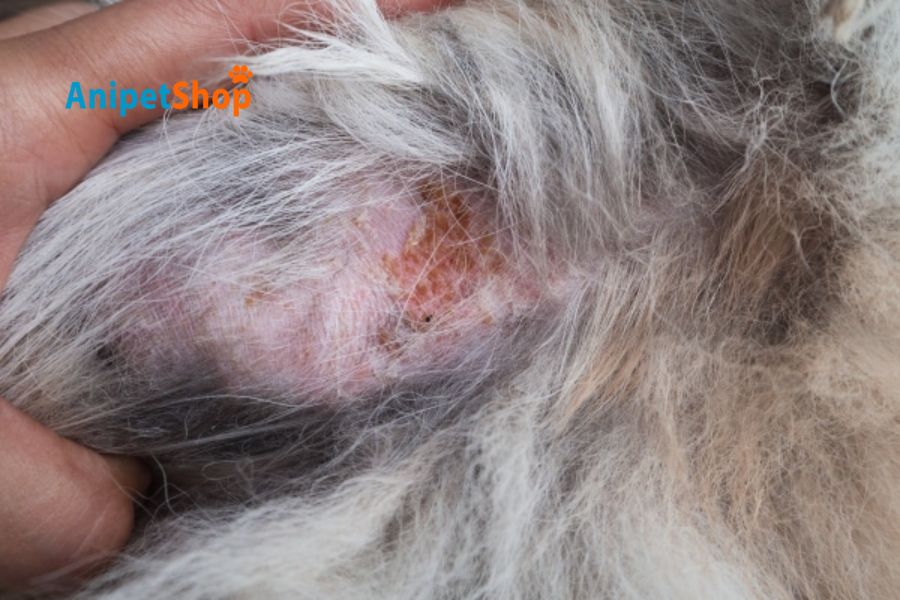
- Flea dirt (flea feces): often accumulates in the dog’s coat and resembles tiny black specks or grains of sand. This gritty residue is composed of digested blood and flea waste and is a telltale sign of a flea infestation on the dog.
Immediate Treatments for Flea Bites
As dogs endure the discomfort of flea bites, swift action becomes imperative, prompting the exploration of immediate treatments to alleviate their irritation and promote their well-being.
First Aid
First aid for flea bites on dogs begins with a thorough cleaning of the affected area using a mild soap and water solution, ensuring that any dirt or debris surrounding the bite site is gently removed. Following cleansing, applying a cool compress to the affected area can help alleviate itching and reduce inflammation. The coolness of the compress provides temporary relief, soothing the irritated skin and minimizing discomfort caused by flea bites.
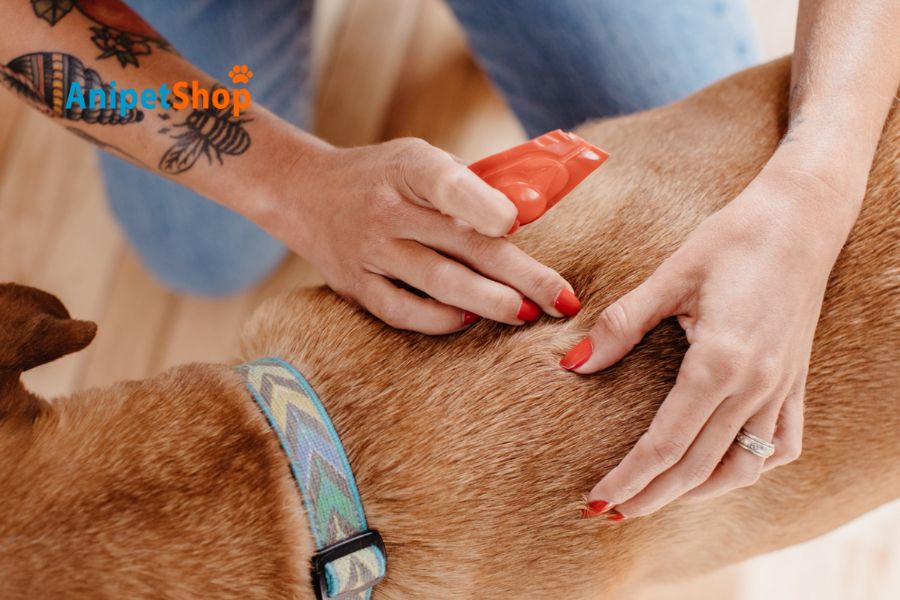
Soothing Dog Shampoos
Soothing dog shampoos offer targeted relief for canines afflicted by flea bites, with various formulations tailored to alleviate irritation and promote healing. Oatmeal-based shampoos are popular choices, known for their anti-inflammatory properties that help reduce itching and redness. Additionally, oatmeal is prized for its moisturizing effects, which can soothe dry, irritated skin caused by flea bites. Aloe vera-based shampoos provide a cooling sensation, offering immediate relief to dogs suffering from itchiness and inflammation. Moreover, aloe vera’s healing properties can aid in the regeneration of damaged skin, promoting faster recovery from flea bites. However, when considering tea tree oil shampoos, caution is advised. While diluted tea tree oil may possess antifungal and antibacterial properties beneficial for treating flea-related skin infections, it can be toxic if ingested by dogs in large quantities.
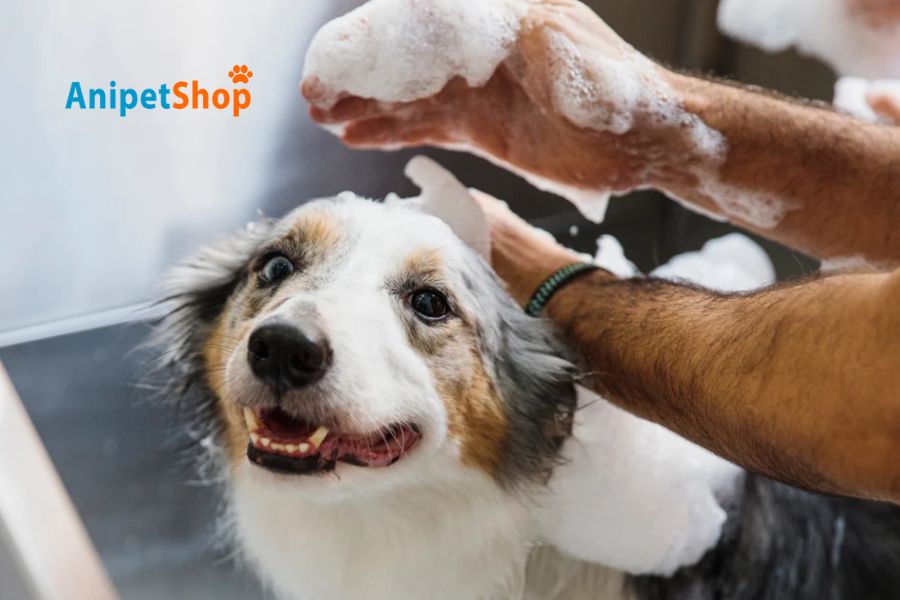
Topical Medications
Topical medications serve as valuable tools in managing the discomfort and potential complications associated with flea bites on dogs. Hydrocortisone creams, such as Cortaid, offer temporary relief from itching and inflammation, making them a staple in many first-aid kits for pets. However, it’s essential to use them sparingly and under veterinary guidance, as prolonged or excessive use can lead to skin thinning. Antiseptic solutions like chlorhexidine or povidone-iodine (e.g., Betadine) play a crucial role in cleaning wounds and preventing infections in areas where the skin may be broken due to excessive scratching. For minor skin infections, antibiotic ointments containing bacitracin, neomycin, and polymyxin B (e.g., Neosporin) can be applied topically to promote healing. While some pet owners opt for natural alternatives like diluted tea tree oil, coconut oil, or aloe vera gel for their soothing properties, it’s imperative to consult with a veterinarian before using these remedies, as they may carry risks or interact with other treatments.
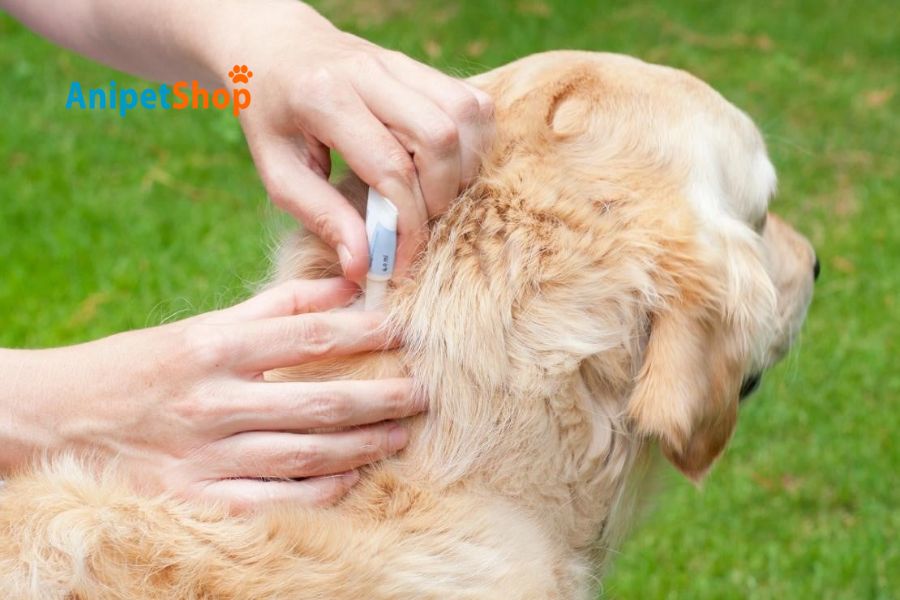
Diagnosing Flea Allergy Dermatitis (FAD)
Flea Allergy Dermatitis (FAD) presents a distinctive set of symptoms that extend beyond the typical reactions to flea bites, indicating a heightened sensitivity to flea saliva.
Symptoms Beyond Typical Bites
Dogs suffering from FAD often exhibit symptoms that surpass mere irritation from flea bites:
- Intense itching, even with minimal flea exposure: Dogs with FAD experience relentless itching, sometimes even in the absence of visible fleas. This persistent itching is a hallmark of the allergic reaction to flea saliva.
- Open sores, crusting, and significant hair loss: The constant scratching and biting induced by FAD can lead to the development of open sores and areas of crusted skin. Moreover, extensive scratching may result in notable hair loss, particularly in regions where fleas commonly target, such as the base of the tail and the hindquarters.
- Recurring skin infections: Compromised skin integrity from incessant scratching increases the likelihood of secondary bacterial or fungal infections. These recurrent skin infections further exacerbate the discomfort and inflammation associated with FAD.
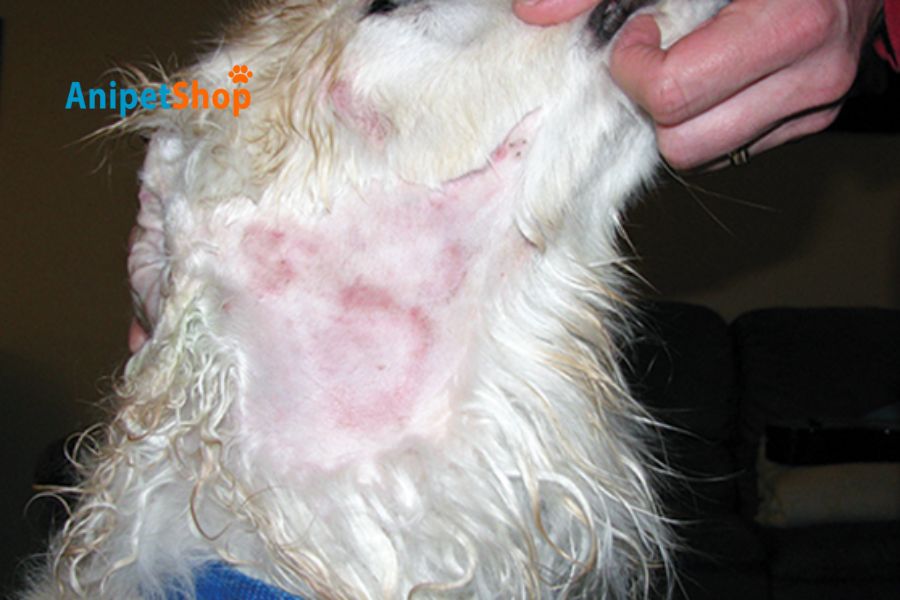
Diagnostic Methods
Diagnosing FAD requires a multifaceted approach, encompassing clinical observation and specialized tests:
-
- Veterinary examination and flea evidence: A thorough physical examination by a veterinarian is crucial to assess the dog’s symptoms and identify any evidence of flea infestation or flea bite lesions. The presence of fleas, flea dirt, or flea-related skin lesions provides initial confirmation of FAD.
- Intradermal allergy tests: These tests involve injecting small amounts of flea allergens under the dog’s skin to observe any allergic reactions. By identifying specific flea bite allergens that trigger a response, intradermal allergy tests help pinpoint the exact cause of the allergic reaction in FAD-affected dogs.
- IgE blood tests: IgE blood tests measure the levels of flea allergy antibodies (immunoglobulin E) in the dog’s bloodstream. Elevated IgE levels indicate the presence of an allergic response to flea saliva, supporting the diagnosis of Flea Allergy Dermatitis.
igE blood test for dogs
Comprehensive Treatment Approaches
1. Flea Control is Key:
Effective flea control is paramount in managing Flea Allergy Dermatitis (FAD). Eliminating fleas from the dog’s environment and preventing reinfestation are fundamental steps in alleviating symptoms and preventing future allergic reactions. This involves rigorous flea control measures such as regular vacuuming, washing bedding in hot water, and using flea preventatives recommended by veterinarians.

2. Oral Flea Medications:
Oral flea medications offer fast-acting relief by targeting fleas systemically. Options include prescription medications like Bravecto, NexGard, and Comfortis, which disrupt the flea life cycle or kill adult fleas upon ingestion. Bravecto, for instance, provides up to 12 weeks of protection with a single dose. NexGard contains afoxolaner, which kills fleas by overstimulating their nervous systems upon biting.
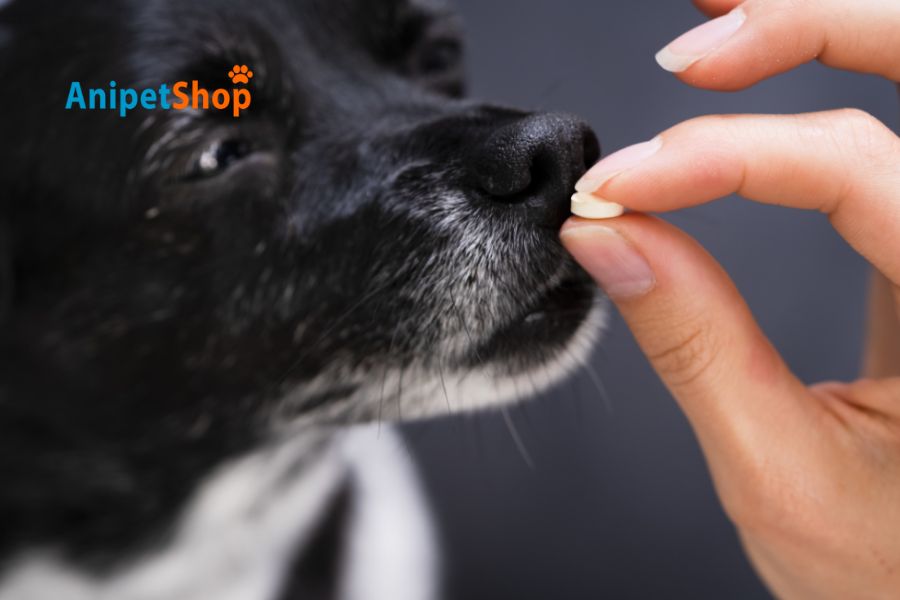
3. Steroids and Nonsteroids:
In cases of severe itching and inflammation associated with FAD, short-term use of steroids may be necessary to provide relief. However, due to potential side effects, such as increased thirst, appetite, and risk of immunosuppression, their use is typically limited and closely monitored by veterinarians. Alternatively, newer non-steroidal options like Apoquel (oclacitinib) and Cytopoint (lokivetmab) offer targeted relief with fewer systemic side effects. Apoquel works by inhibiting the activity of certain enzymes involved in the itch response, while Cytopoint is a monoclonal antibody that specifically targets and neutralizes the itch-inducing cytokine interleukin-31.
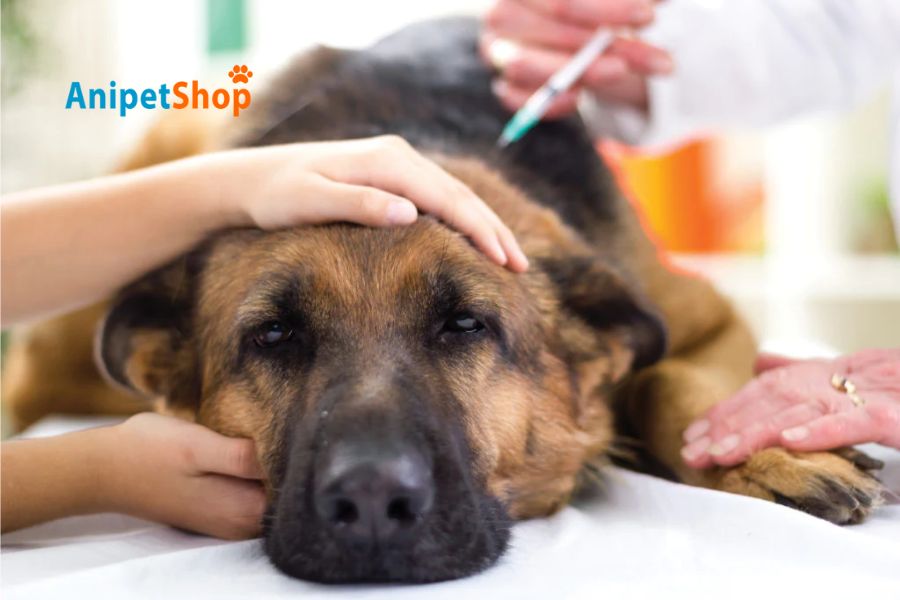
4. Secondary Infections:
Addressing secondary bacterial or fungal infections is crucial in the comprehensive treatment of FAD. Antibiotics, such as cephalexin or amoxicillin-clavulanic acid, are commonly prescribed to treat bacterial infections resulting from self-inflicted wounds or broken skin. Antifungal medications, such as ketoconazole or fluconazole, may be necessary to combat fungal infections that can arise in moist, inflamed skin.

Environmental Management for Flea Control
1. Environmental Management for Flea Control
Effective environmental management plays a critical role in controlling flea infestations and preventing reinfestation in both the home and yard. In the home, thorough cleaning is essential to eliminate flea eggs, larvae, and adult fleas hiding in carpets, rugs, and furniture. Regular vacuuming with a high-powered vacuum cleaner can help remove flea eggs and larvae from carpets and upholstery while washing dog beds and blankets in hot water kills fleas and their eggs.

2. Yard Control
Controlling fleas in outdoor areas is equally important to prevent reinfestation of pets and the home. Treating grassy areas, shaded spots, and other potential flea habitats with targeted pesticides can help eradicate fleas and disrupt their life cycle. Consultation with a veterinarian or pest control expert is recommended to determine the most appropriate and safe pesticide treatment for outdoor spaces.

FAQs
How do I know if my dog has fleas?
You can typically tell if your dog has fleas by observing certain signs and behaviors. Look for excessive scratching, biting, or licking, particularly around the base of the tail, back, and belly. Flea dirt, which looks like small black specks, may be visible on your dog’s fur or skin. Additionally, you may notice red bumps or irritated skin, indicating flea bites.
What’s the best flea medication for my dog?
The best flea medication for your dog depends on various factors, including your dog’s age, weight, health status, and lifestyle. Popular choices among pet owners include spot-on treatments like Frontline Plus, oral medications such as Bravecto or NexGard, and flea collars like Seresto.
Are flea bites dangerous for dogs?
While flea bites themselves may not be inherently dangerous for dogs, they can cause significant discomfort and irritation, particularly in cases of Flea Allergy Dermatitis (FAD). Dogs with FAD have an allergic reaction to flea saliva, leading to intense itching, skin inflammation, and potential secondary infections.
Can humans get flea bites from dogs?
Yes, humans can get flea bites from dogs. While fleas prefer to feed on animals, including dogs and cats, they may bite humans if their preferred hosts are unavailable. Flea bites on humans typically appear as small, red, itchy bumps and can occur on any part of the body, particularly areas where clothing fits tightly.
Conclusion
Proactive flea control is paramount in ensuring the health and comfort of dogs. Prevention stands as the most effective method to shield them from the distress and potential health complications caused by flea infestations. By prioritizing preventive measures such as regular use of flea preventatives, meticulous home cleaning, and timely veterinary consultations, dog owners can effectively safeguard their pets. It’s crucial to acknowledge the invaluable partnership between dog owners and veterinarians in implementing comprehensive flea control strategies tailored to each dog’s specific needs.
Lily Watson is an author specializing in veterinary care in Australia. With a profound passion for animal welfare and a solid foundation in veterinary science, Lily has dedicated herself to disseminating valuable knowledge and information for both pet owners and professionals in this field.

